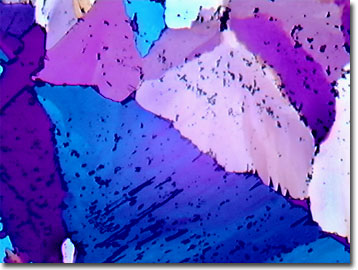Polarized Light Digital Image Gallery
Inositol
Naturally found in green leafy vegetables, inositol is a water-soluble sugar that performs well as a fat emulsifier, an anti-anxiety agent, a controller of serum cholesterol, and helps maintain healthy hair. Also known as meat sugar, inositol, a non-essential vitamin/sugar, is vital for cell membrane functioning and maintenance.

The inositols are ubiquitous, cyclic carbohydrates with a basic six-carbon ring structure. In mammals, there are nine known isomers with myo-inositol being the most abundant in the central nervous system. Known to biochemists also as hexahydrocyclohexane, inositol features 6 carbons, 12 hydrogens, and 6 oxygen atoms (note the one-to-one correspondence of water and carbon) in its relatively simple structure, with a molecular weight of 180.16. As a synthesized solid, inositol is an odorless white crystal that melts at 224 degrees Centigrade.
Because amines, polypeptides, and glycoproteins cannot penetrate the lipid layer of cell membranes, alternative activators, such as inositol, are required. Inositol also apparently plays an important role in releasing calcium stored in the cellular endoplasmic reticulum when it is needed, and in nerve cells and kidneys, the sugar helps maintain osmoregulation by controlling the sodium pump.
This carbohydrate plays an important part in the health of cell membranes, especially for the specialized cells of the brain, bone marrow, eye, and intestines. Other benefits include promoting hair growth, controlling estrogen levels, (probably) preventing breast lumps, and possibly impeding or preventing male baldness. Most recently, problems involving the central nervous system (CNS), including depression, Alzheimer's disease panic disorders, and obsessive-compulsive disorders, seem to respond to inositol therapy. However, it is counterindicated for schizophrenia, which may involve elevated activity of the phosphoinositol signaling system. Higher concentrations of inositol are found in the eye lens and the heart of healthy people, and deficiencies of this carbohydrate are indicated by high cholesterol levels, abnormalities of the eyes, constipation, eczema, and hair loss.
In its natural form, taken as part of the diet or as an extraction or synthesized supplement, the United States Food and Drug Administration's recommended daily allowance (RDA) is 100 milligrams per day. For optimal functioning of inositol, the entire B group of vitamins, choline, vitamin E, vitamin C, folic acid, and linoleic acid should be an integral part of the dietary intake. Coffee drinkers and people on antibiotics need additional inositol to maintain its benefits.
Natural sources of inositol include wheat germ, brewer's yeast, bananas, liver, brown rice, oak flakes, nuts, unrefined molasses, vegetables, and raisins. Available naturally from plant and animal sources, the plant form of inositol is combined with six phosphates and is known as the "anti-nutrient" phytic acid. In plants, phytic acid binds with minerals, such as iron and calcium, and interferes with their absorption. Mammals, including humans, can also biosynthesize inositol from glucose and patients with diabetes mellitus, chronic kidney failure, and multiple sclerosis (MS), exhibit impaired production.
Contributing Authors
Omar Alvarado, Thomas J. Fellers and Michael W. Davidson - National High Magnetic Field Laboratory, 1800 East Paul Dirac Dr., The Florida State University, Tallahassee, Florida, 32310.
BACK TO THE POLARIZED LIGHT IMAGE GALLERY
BACK TO THE DIGITAL IMAGE GALLERIES
Questions or comments? Send us an email.
© 1995-2025 by Michael W. Davidson and The Florida State University. All Rights Reserved. No images, graphics, software, scripts, or applets may be reproduced or used in any manner without permission from the copyright holders. Use of this website means you agree to all of the Legal Terms and Conditions set forth by the owners.
This website is maintained by our
Graphics & Web Programming Team
in collaboration with Optical Microscopy at the
National High Magnetic Field Laboratory.
Last Modification Friday, Nov 13, 2015 at 01:19 PM
Access Count Since September 17, 2002: 14846
Visit the website of our partner in introductory microscopy education:
|
|
